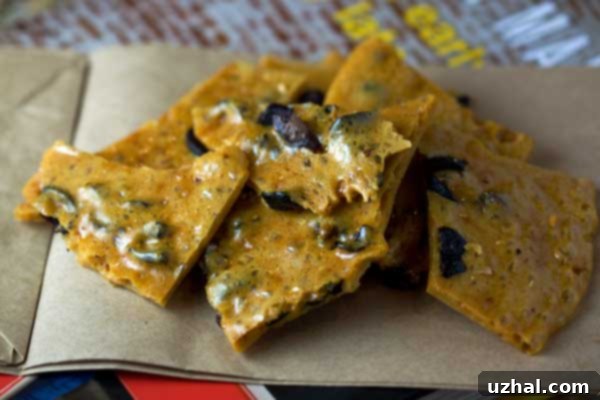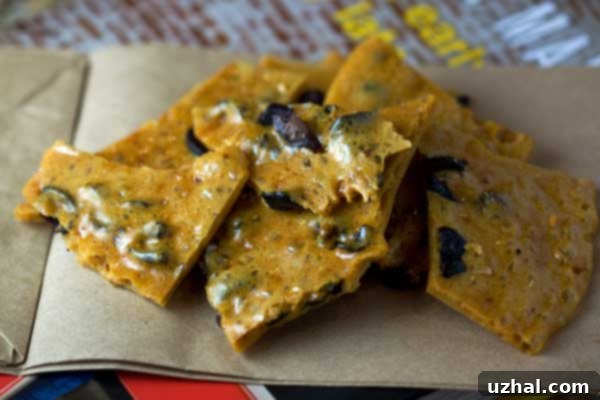Unique Sweet and Savory Olive Brittle: A Culinary Adventure from Chef Brian Malarkey’s ‘Come Early Stay Late’
Embark on a unique culinary adventure with a recipe that defies expectations: Olive Brittle. This intriguing creation comes from the pages of Come Early Stay Late, the celebrated cookbook by chef Brian Malarkey. Known to many from his captivating appearances on Top Chef Miami, Brian Malarkey is more than just a television personality; he is a culinary icon in San Diego, a creative force whose innovative vision has shaped a remarkable collection of restaurants. His establishments, including Searsucker, Burlap, Gingham, Gabardine, and Herringbone, are renowned for their inventive menus and vibrant dining experiences.
Malarkey’s cookbook is not merely a compilation of dishes; it’s a personal narrative, chronicling his fascinating journey through the culinary world, interspersed with signature recipes from his esteemed restaurants. The book promises a delightful array of flavors, from refreshing starters like “Summer Loving Watermelon Salad” and intriguing sides such as “Sauteed Shishito Peppers,” to more elaborate entrees like the “Chicken Brie Sandwich with Tarragon Aioli.” Among the many tempting recipes, two have already become personal favorites in my kitchen: the decadent “Carrot Cake Plus Ginger Cream Cheese Frosting” and, of course, this wonderfully surprising Olive Brittle.
The Sweet Genius Behind the Savory Twist: Pastry Chef Rachel King
While Brian Malarkey’s name graces the cover, he generously attributes all the extraordinary desserts in “Come Early Stay Late” to the immense talent of his pastry chef, Rachel King. King’s philosophy of creating “classics with a twist” truly shines through in every sweet offering. Beyond the aforementioned Olive Brittle and Carrot Cake, the dessert chapter is a treasure trove of imaginative delights. Readers will find recipes for Searsucker’s signature “Apple & Ale Muffins,” charming “Red Velvet Sandwich Cookies,” a zesty “Key Lime Pie,” indulgent “Lemon Bars” (which notably call for a generous seven eggs, promising rich flavor!), and delightful “Coconut-Filled Brownies.”
The sheer creativity and deliciousness of these desserts left such an impression that, as much as I admire Malarkey’s comprehensive book, I find myself eagerly wishing for a dedicated cookbook from Rachel King. Her ability to elevate familiar favorites into something truly special is remarkable, making the dessert section alone worth the price of admission for “Come Early Stay Late.” Her work represents a fresh perspective on traditional sweets, showcasing how a touch of innovation can transform a classic into an unforgettable experience.
Discovering the Allure of Olive Brittle: A Sweet and Salty Revelation
But let’s return to the star of today’s feature: the Olive Brittle. This particular recipe stands out as genuinely unique and, frankly, quite different from any brittle you’ve likely encountered. It skillfully balances sweet caramel with the distinctly savory, slightly briny notes of olives, creating a flavor profile that is both unexpected and surprisingly addictive. It’s not a traditional dessert meant to be consumed in large portions after a heavy meal. Instead, its charm lies in its versatility and intriguing complexity.
Imagine serving this brittle as an elegant sweet appetizer, a sophisticated palate cleanser before a main course, or as an utterly delightful and conversation-starting snack at your next cocktail party. Its crisp texture and balanced sweet-savory punch make it a perfect companion to a glass of wine or a craft cocktail. Furthermore, this Olive Brittle makes for an absolutely fabulous and memorable hostess gift. Picture arriving at a gathering with a beautifully packaged brittle that challenges expectations and delights the senses – it’s sure to be a talking point. In fact, if someone were to present me with this as a gift, I confess I wouldn’t be able to wait; I’d have to tear into it and savor its distinct flavor on the spot!
Mastering the Art of Olive Brittle: Essential Tips for Home Bakers
Making brittle, while seemingly simple, involves precision, particularly when it comes to temperature. The original recipe, shared below, is faithfully reproduced from the book, but I’ve included some invaluable personal notes gathered from my own experience to help you achieve perfect results. The absence of specific temperature guidance in the original can be challenging, as knowing exactly when to remove candy from the heat is a skill that develops with practice and, often, with the aid of a trusty candy thermometer. My initial attempt at this brittle resulted in an undercooked batch, reinforcing the critical need for accurate temperature readings. For my second, successful attempt, I used a candy thermometer, adding the butter when the mixture reached approximately 290°F and removing the candy from the heat precisely at 300°F. This attention to temperature ensures the ideal brittle consistency – crisp, not chewy.
Another crucial detail involves the olives themselves. I strongly recommend chopping them into very small, uniform pieces. In my first batch, the olive pieces were somewhat large, and while still tasty, the texture wasn’t as harmonious. The second batch, with its finely chopped olives, was overwhelmingly preferred for its more integrated flavor and pleasing crunch. Remember, different burner sizes and types of pans can affect cooking times and heat distribution, so you might find that medium-high heat works better than high heat for a more controlled caramelization process.
Patience is also key, as this Olive Brittle takes a little longer than some other brittles to fully set and harden. Don’t be discouraged if it doesn’t firm up immediately; it requires complete cooling before it reaches its signature crispness. Once cooled, break it into irregular, bite-sized pieces for easy enjoyment. Stored in an airtight container, this extraordinary sweet-savory brittle will keep its freshness for up to a week, though it’s so good, it rarely lasts that long!
Here’s the detailed recipe as written in the book, along with my personal notes to guide you toward brittle perfection:
Recipe

Come Early Stay Late Olive Brittle
Cookie Madness
Pin Recipe
Ingredients
- ½ cup olives pitted and finely chopped (I used briny Kalamata olives for their robust flavor)
- ½ cup water
- 1 cup granulated sugar
- ½ cup light corn syrup
- 1 tablespoon of butter
- 1 teaspoon of baking soda for aeration, which creates the brittle’s signature light, bubbly texture
Instructions
-
Preheat your oven to 300 degrees F (150 degrees C).
-
Spread the finely chopped olives evenly on a small sheet tray. Bake them in the preheated oven until they are thoroughly dry, which should take approximately 1 hour. This step is crucial for achieving the right texture in the brittle.
-
In a medium, heavy-bottomed saucepan, combine the water, granulated sugar, and light corn syrup. Place the saucepan over high heat. Cook the mixture, stirring occasionally, until it reaches a beautiful golden brown color. This typically takes about 8 to 10 minutes. Watch closely to prevent burning.
-
Once the sugar mixture has reached the desired color, stir in the butter. Continue cooking, stirring constantly, until the butter is completely melted and fully incorporated into the syrup. Immediately remove the saucepan from the heat and quickly stir in the baking soda. The mixture will foam up significantly, which is normal and creates the brittle’s airy texture.
-
Without delay, stir in the dried olives. Immediately pour the entire mixture out onto a Silpat silicone baking mat or a parchment-lined sheet pan. If you desire a thinner brittle, you can gently flatten it with another Silpat, a layer of wax paper, and a rolling pin. However, I personally preferred not to flatten it too much to preserve the delightful air bubbles that form (which contribute to the crispness).
-
Allow the brittle to cool completely and undisturbed. This can take some time, but it’s essential for it to harden properly. Once fully cooled and set, break the brittle into irregular, bite-sized pieces. Store any leftovers in an airtight container at room temperature for up to 1 week to maintain its freshness and crunch.
Notes
Temperature Control is Crucial: The original recipe lacks specific temperature guidance, which can be tricky for brittle. I highly recommend using a candy thermometer. For optimal results, add the butter when your sugar mixture reaches approximately 290°F (143°C) and remove the entire mixture from the heat when it hits 300°F (149°C). This ensures proper caramelization and the perfect brittle snap. Different stovetops and pans will conduct heat differently, so you may find that using medium-high heat rather than constant high heat provides more control and prevents scorching.
Patience for Setting: Don’t rush the cooling process. This brittle may take a bit longer to set and harden compared to traditional nut brittles. It will not achieve its desired crisp texture until it is completely cool, so allow ample time.
I hope you’ll give this extraordinary Olive Brittle a try. It’s a delightful demonstration of how unexpected ingredients can come together to create something truly memorable and delicious. Whether you’re a seasoned chef or a home cook looking for an exciting new challenge, this recipe from Brian Malarkey’s “Come Early Stay Late” offers a fantastic opportunity to explore bold flavors and impress your guests with a genuinely unique treat. Share your experiences, tips, and modifications in the comments below – I’d love to hear how this sweet-savory brittle transforms your culinary repertoire!
